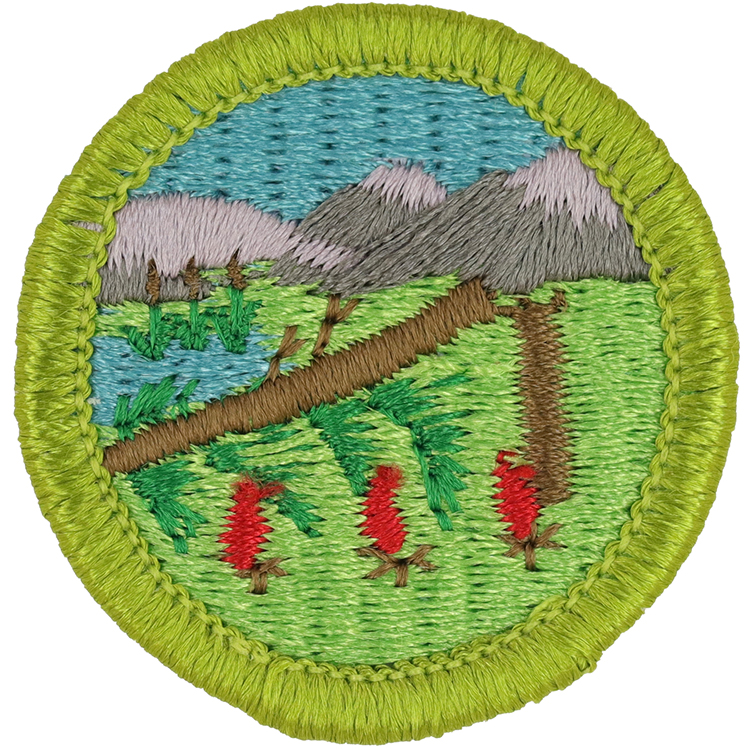Requirements January 1984 until September 1995
1. From memory, describe the priorities for survival in a backcountry or wilderness location.
2. Describe ways to (a) avoid panic and (b) maintain a high level of morale when lost.
3. Show that you know first aid for injuries or illnesses likely to occur in backcountry outings, including hypothermia, hyperthermia, heat stroke, heat exhaustion, frostbite, dehydration, sunburn, stings, ticks, snakebite, blisters, and hyperventilation.
4. Tell what you would do to survive in the following environments:
(a) Cold and snowy
(b) Wet (forest)
(c) Hot and dry (desert)
(d) Windy (mountains or plains)
(e) Water (ocean or lake)
5. Make up a small survival kit and be able to explain how each item in it is useful.
6. Show that you can start fires using three methods other than matches.
7. Do the following:
(a) Tell five different ways of attracting attention when lost.
(b) Show how to use a signal mirror to attract attention when lost.
(c) From memory, describe five international ground-to-air signals and tell what they mean.
8. Show that you can find and improvise a natural shelter minimizing the damage to the environment.
9. Spent a night in your shelter.
10. Explain how to protect yourself against insects, reptiles, rodents, and bears.
11. how three ways to purify water.
12. Show that you know the proper clothing to be worn in your area on an overnight in extremely hot weather and extremely cold weather.
13. Explain why it usually is not wise to eat edible wild plants or wildlife in a wilderness survival situation.
Requirements September 1995 until January 2001
1. Show that you know first aid for injuries or illnesses likely to occur in backcountry outings, including hypothermia, hyperthermia, heatstroke, heat exhaustion, frostbite, dehydration, sunburn, stings, tick bites, snakebite, blisters, and hyperventilation.
2. From memory, describe the priorities for survival in a backcountry or wilderness location.
3. Describe ways to (a) avoid panic and (b) maintain a high level of morale when lost.
4. Tell what you would do to survive in the following environments:
(a) Cold and snowy
(b) Wet (forest)
(c) Hot and dry (desert)
(d) Windy (mountains or plains)
(e) Water (ocean or lake)
5. Make up a small survival kit and be able to explain how each item in it is useful.
6. Show that you can start fires using three methods other than matches.
7. Do the following:
(a) Tell five different ways of attracting attention when lost.
(b) Show how to use a signal mirror to attract attention when lost.
(c) From memory, describe five international ground-to-air signals and tell what they mean.
8. Show that you can find and improvise a natural shelter minimizing the damage to the environment.
9. Spent a night in your shelter.
10. Explain how to protect yourself against insects, reptiles, rodents, and bears.
11. Show three ways to purify water.
12. Show that you know the proper clothing to be worn in your area on an overnight in extremely hot weather and extremely cold weather.
13. xplain why it usually is not wise to eat edible wild plants or wildlife in a wilderness survival situation.
Requirements January 2001 until January 2008
1. Show that you know first aid for injuries or illnesses likely to occur in backcountry outings, including hypothermia, heatstroke, heat exhaustion, frostbite, dehydration, sunburn, stings, tick bites, snakebite, and blisters.
2. Describe from memory the priorities for survival in a backcountry or wilderness location.
3. Describe ways to (a) avoid panic and (b) maintain a high level of morale when lost.
4. Tell what you would do to survive in the following environments:
(a) Cold and snowy
(b) Wet (forest)
(c) Hot and dry (desert)
(d) Windy (mountains or plains)
(e) Water (ocean or lake)
5. Make up a personal survival kit and be able to explain how each item in it is useful.
6. Show that you can start fires using three methods other than matches.
7. Do the following:
(a) Tell five different ways of attracting attention when lost.
(b) Show how to use a signal mirror.
(c) Describe from memory five international ground-to-air signals and tell what they mean.
8. Show that you can find and improvise a natural shelter minimizing the damage to the environment.
9. Spent a night in your shelter.
10. Explain how to protect yourself against insects, reptiles, rodents, and bears.
11. Show three ways to treat water found in the outdoors to prepare it for drinking.
12. Show that you know the proper clothing to wear in your area on an overnight in extremely hot weather and extremely cold weather.
13. Explain why it usually is not wise to eat edible wild plants or wildlife in a wilderness survival situation.






